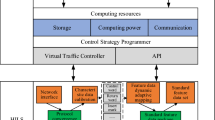Abstract
Modern traffic signal control systems provide Emergency Vehicle Preemption (EVP), which provides the right-of-way to emergency vehicles in preference to other vehicles. Traffic engineers should select the best coordination recovery strategy at the end of the preemption in order to minimize any resulting disruptions. This paper compares the various EVP methods available with a controller used in the USA. The comparison was conducted in an urban corridor including four coordinated-actuated signals using a Hardware-In-the-Loop Simulation (HILS), which consisted of a well-calibrated VISSIM microscopic simulation model and four Type 170 controllers. The examined preemption strategies included shortway and dwell with different numbers of cycles for transition completion. The results of the comparison indicated that the resulting impact on the network-wide and intersection-specific performances varied with the selected EVP method. The results also indicated that the EVP function using a shortway transition method with two or three cycles worked the best, as it could minimize the impacts of EVP.
Similar content being viewed by others
References
BI Tran Systems, Inc. (1994). Model 170E controller traffic signal program 233 VA, Sacramento, California.
BI Tran Systems, Inc. (2000). QuicLoad user’s manual, Sacramento, California.
McCain/NIATT (2002). Controller Interface Device (CID II): User manual version 2.0, McCain Traffic Supply.
Nelson, E. J. and Bullock, D. (2000). “Impact of emergency vehicle preemption on signalized corridor operation: An evaluation.” Transportation Research Record, Vol. 1727, pp. 1–11.
Obenberger, J. and Collura, J. (2001). “Transition strategies to exit preemption control: State-of-the-practice assessment.” Transportation Research Record, Vol. 1748, pp. 72–79.
Park, B. and Qi. H. (2005). “Development and evaluation of simulation model calibration procedure.” Transportation Research Record, Vol. 1934, pp. 208–217.
Park, B., Won, J., and Yun, I. (2006). “Application of microscopic simulation model calibration and validation procedure: A case study of coordinated actuated signal system.” Transportation Research Record, Vol. 1978, pp. 113–122.
Shelby, S. G., Bullock, D., and Gettman, D. (2006). “Transition methods in traffic signal control.” Transportation Research Record, Vol. 1978, pp. 130–140.
Yun, I., Best, M. and Park, B. (2008). “Evaluation of transition methods of the 170E and 2070 ATC traffic controllers after emergency vehicle preemption.” Journal of Transportation Engineering, Vol. 134, No. 10, pp. 423–341.
Author information
Authors and Affiliations
Corresponding author
Rights and permissions
About this article
Cite this article
Yun, I., Park, B.B., Lee, C.K. et al. Comparison of Emergency Vehicle Preemption methods using a Hardware-In-The-Loop simulation. KSCE J Civ Eng 16, 1057–1063 (2012). https://doi.org/10.1007/s12205-012-1447-2
Received:
Revised:
Accepted:
Published:
Issue Date:
DOI: https://doi.org/10.1007/s12205-012-1447-2




